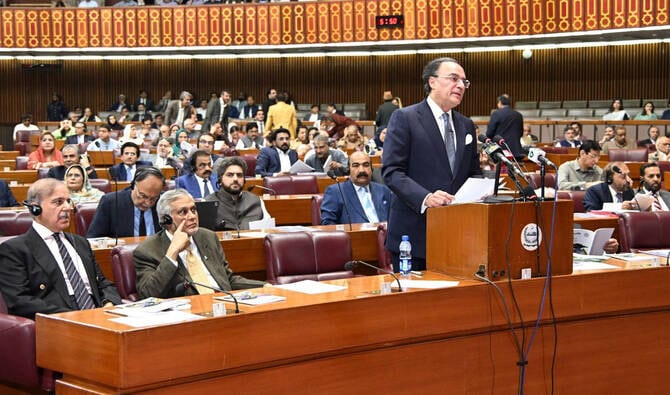Written by: Naveed Rafaqat Ahmad
The federal budget for the fiscal year 2025–26 (FY26) represents a determined step toward economic recovery, stability, and long-term sustainability. After years of economic challenges—ranging from high inflation, sluggish growth, climate shocks, and geopolitical tensions—this budget is built on a vision of stronger public revenue, targeted expenditure, and national security readiness. While critics have focused on selective headlines, a deeper look reveals that the FY26 budget is neither austerity-driven nor reckless. Instead, it attempts a fine balance: boosting government revenues without strangling the economy, increasing defence preparedness without neglecting welfare, and targeting growth without triggering inflation. It is a forward-looking document aimed at preserving national dignity, sustaining development, and fulfilling the aspirations of a resilient people.
The government of Pakistan has set an ambitious target of raising 14% to 18% more revenues in FY26 compared to the previous year. This increase is not being achieved through arbitrary hikes in existing taxes on salaried classes or production sectors. Instead, the strategy reflects a long-overdue policy shift toward broadening the tax base. For decades, key sectors of the economy—especially agriculture, real estate, and retail—have remained largely untaxed or grossly under-taxed, even though they represent a substantial share of national wealth. Agriculture contributes nearly 23% of GDP but less than 1% of tax revenues. Real estate is estimated to be worth over PKR 7 trillion, yet tax collection from this sector has been minimal. The retail sector, which accounts for 18% of GDP and employs millions, also remains largely informal.
In the FY26 budget, the government has introduced targeted measures to bring these sectors into the mainstream. Agricultural income tax is being streamlined across provinces, with federal cooperation to ensure consistency. Large landholders will now face transparent reporting requirements and effective collection, while small farmers with less than 12.5 acres remain exempt. In real estate, new valuation tables based on market rates have been introduced nationwide, with capital gains taxes rationalized to target speculative trading. Retailers will now be part of a digitally integrated Point-of-Sale (POS) system, with over 100,000 shops to be linked by December 2025. These reforms not only improve fairness but also promise to significantly raise revenue without hurting productivity.
According to estimates from the Federal Board of Revenue (FBR), these new measures, combined with improved compliance and digital monitoring, are expected to increase total federal tax collection to over PKR 13.5 trillion in FY26, compared to PKR 11.4 trillion in FY25. The tax-to-GDP ratio, which has lingered below 10% for years, is projected to rise to 11.6%, marking a significant improvement. Importantly, the government has promised that these gains will be used to fund development projects, improve human capital, and reduce borrowing—not to feed waste or unproductive bureaucracy.
The government has also maintained a responsible posture on spending. Non-defence current expenditures have been capped at 7% growth, significantly below the expected inflation rate of 10%—a move that reflects fiscal discipline. Ministries and divisions have been instructed to eliminate redundant schemes, focus on performance-based budgeting, and shift to digital procurement to save costs. At the same time, the Public Sector Development Programme (PSDP) has been protected at PKR 1.2 trillion, with a focus on high-impact projects in energy, water, health, and education. For example, the Diamer-Bhasha Dam, the Mohmand Hydropower Project, and several motorway links are being prioritized for completion by 2027, while major investments are being channeled into solar energy and irrigation projects under the Green Pakistan Initiative.
One of the most discussed features of the FY26 budget has been the increase in defence expenditure, estimated at around PKR 2.15 trillion, marking a rise of 17% to 20% compared to FY25. While this increase has raised questions in some quarters, it must be understood in the correct strategic context. Pakistan faces growing security challenges on multiple fronts. The eastern border remains under tension following India’s continued military buildup and aggressive posture post-Article 370. Along the western frontier, cross-border terrorism and instability in Afghanistan continue to threaten national security. Internally, Pakistan has made enormous sacrifices in fighting terrorism, and the revival of hostile networks requires continued vigilance.
Much of the increased defence budget is not being spent on luxuries or ceremonial purposes but on modernization, intelligence capacity, and border surveillance. A major chunk of the funds is dedicated to the procurement of next-generation radar, drones, communications systems, and enhanced mobility for troops in difficult terrains. The Pakistan Air Force is also updating its fleet with joint production programs and locally manufactured platforms, reducing import dependency. The Navy is expanding its role in maritime security under the Indian Ocean initiative, with increased patrols and readiness near Gwadar and the Strait of Hormuz. These investments are vital to maintaining the country’s deterrence capability and ensuring regional peace.
Critics argue that defence should not be prioritized over social spending. But this is a false binary. National security is not separate from development—it is the foundation upon which everything else rests. Without peace, there can be no schools, no jobs, no trade. Pakistan’s regional security threats are not theoretical—they are real, evolving, and immediate. As such, the increase in defence allocation is not a luxury, but a necessity that the state cannot afford to ignore. Moreover, the share of defence in total budgetary outlay remains under 16%, lower than many countries with similar threat perceptions, and defence officials have themselves supported audits and transparency efforts in procurement.
The FY26 budget is also marked by a significant increase in social protection spending. The Benazir Income Support Programme (BISP) allocation has been increased by PKR 80 billion, bringing its total to PKR 550 billion, aimed at supporting over 9 million families. The Ehsaas Nashonuma program, focused on nutrition and child health, has been expanded to cover all 156 districts. A new Education Support Fund of PKR 100 billion has been introduced to reduce dropout rates at secondary level, particularly among girls. These measures reflect the government’s effort to combine fiscal responsibility with compassion.
From a macroeconomic perspective, the FY26 budget aims for a fiscal deficit of 5.9% of GDP, down from 7.4% in FY25. The primary balance is expected to remain in surplus at 0.7%, helping reduce the country’s heavy reliance on borrowing. Domestic borrowing will be limited to PKR 5.3 trillion, while external borrowing is projected at $8.6 billion, mostly from concessional sources such as the World Bank, ADB, and friendly bilateral partners. Importantly, the government has committed to not issuing any new sovereign guarantees for unproductive projects and is introducing a Debt Sustainability Act to cap future debt beyond GDP growth.
The monetary and exchange rate framework remains coordinated with fiscal policy. The State Bank of Pakistan (SBP) has committed to inflation targeting and will continue exchange rate flexibility to avoid past mistakes of artificial currency control. The rupee has stabilized around 280–285 to the dollar, while inflation has moderated to 6.8% in May 2025. If fiscal discipline is maintained, and external shocks are avoided, inflation could fall below 6% in FY26—a major achievement for households and businesses alike.
The business community has generally responded positively to the budget. Chambers of commerce have praised the clarity of taxation rules and the inclusion of long-ignored sectors in the tax net. Exporters have welcomed the continuation of concessional energy pricing for industries, while startups have been granted a three-year tax holiday and access to government-backed venture capital through the new Digital Pakistan Innovation Fund. The agriculture sector is also benefiting from subsidized credit schemes worth PKR 400 billion, along with incentives for mechanization and crop insurance.
One must also credit the broader governance reforms embedded in the budget process. For the first time, the federal budget was debated in a series of live televised sessions, allowing citizens to understand spending priorities and challenge policymakers directly. Gender-responsive budgeting has been made mandatory for all ministries. Climate risk assessments have been incorporated into all major infrastructure projects. These steps demonstrate a maturing political economy where transparency and accountability are gaining ground.
The author holds the position of Director General at the Punjab Sahulat Bazaars Authority.



















